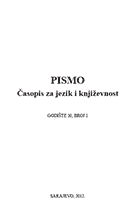Pragmasemantička analiza konceptualnih metafora u dijalozima ekspresionističkih likova Ahmeda Muradbegovića
Pragma-semantic Analysis of Conceptual Metaphors in Ahmed Muradbegović’s Expressionistic Dramas
Author(s): Azra Hodžić-ČavkićSubject(s): Language and Literature Studies
Published by: Bosansko filološko društvo
Keywords: pragmalinguistics; pragma-semantics; politeness theory; negative and positive face; dialogue; speech acts; Bosnian-Herzegovinian drama; metaphor; metaphoric language; metaphoric consciousness; phraseme; phraseologization; metaphorization; metonymization
Summary/Abstract: In this paper we analyze a number of phrases and metaphors used in dialogues of Muradbegović’s heroes with an accent on Lakoff and Johnson’s conceptual metaphor theory. Each of the metaphors used in this paper is presented by a formula which has a starting point and a final target. The starting point is the original domain and the final one represents the target. The dialogues are chosen according to the politeness theory. One of the elements of the politeness theory is the dichotomy in terms of the negative and positive face of the speaker (S) and the listener (L). We have analyzed only dialogues in which the negative face is the one that is dominant. Metaphoric language is the language aware of the present moment. The truth contained within the metaphors is not limited to literal truths. From the semantic point of view, one cannot draw a clear line between literal and figurative language. From the cognitive point of view, operations such as metaphor and metonymy are conceptual in its own nature. Both metaphor and metonymy are processes of copying one structure to another. The metaphors we have observed are seen through the prism of Bosnian culture of the early twentieth century. That means we have analyzed conventional metaphors of the Bosnian language. The assumption is that all analyzed metaphors could be understood by each individual without the need to clarify the target domain. Abstract concepts or spiritual states, as we see from the example, are represented by objective, close, material, less abstract concepts, and contains associative links. It is therefore understandable why love is generally presented as war, especially in the dramas of the early twentieth century, being part of the so-called expressionist circle. That is why rage as a concept is much more vivid if we represent it as a high temperature which causes liquid to come out of its container. In the same way a man comes out of his original selfness and can cause a different kind of negative consequence for the one who is nearby. Language can be understood through concepts. Language, seen through methaphors, becomes a concept.
Journal: Pismo - Časopis za jezik i književnost
- Issue Year: 2012
- Issue No: 10
- Page Range: 84-98
- Page Count: 15
- Language: Bosnian

